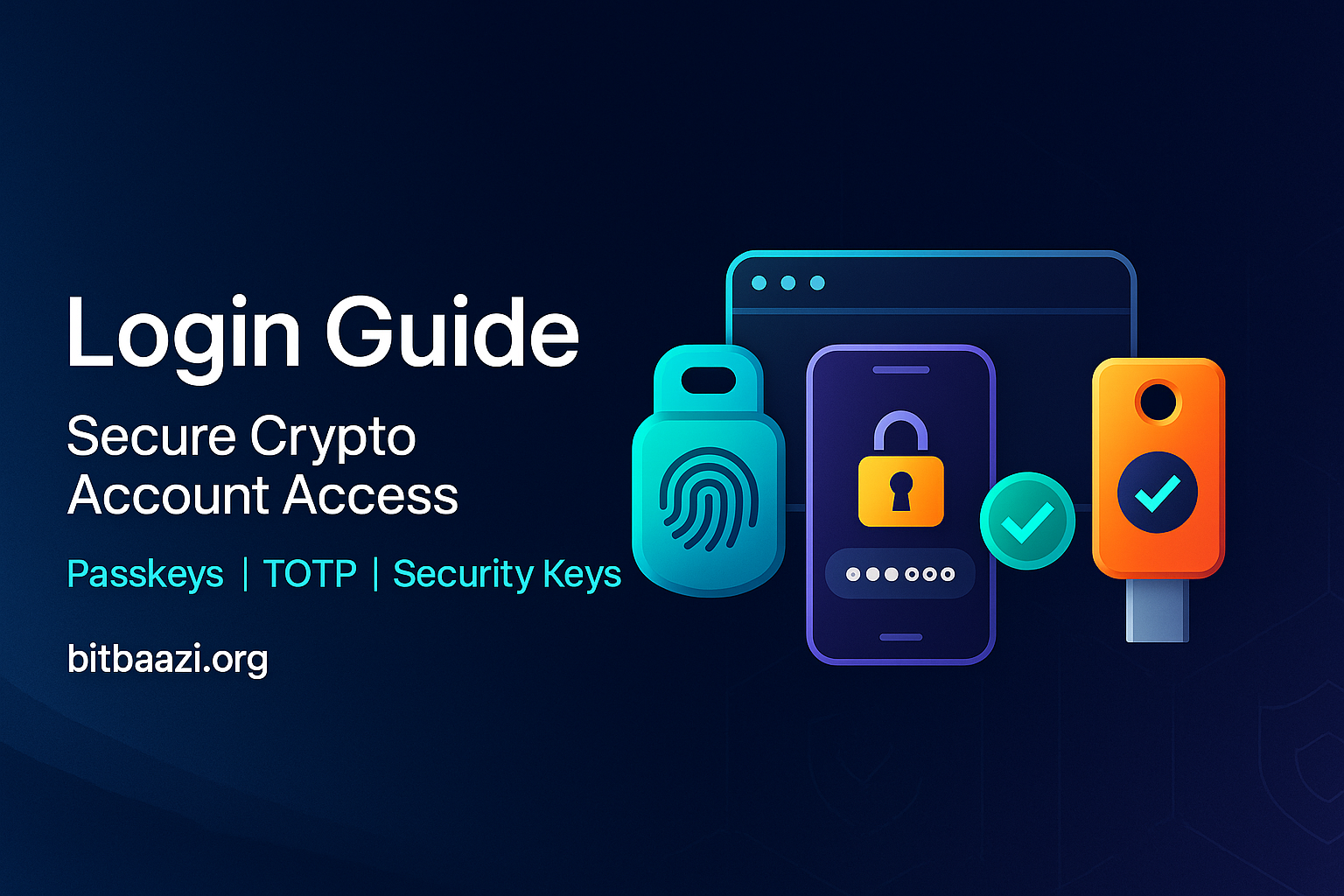Summary
- Use passkeys or security keys for phishing-resistant sign-in.
- Keep TOTP 6-digit codes in an app, not SMS; rotate every 30 seconds.
- Enable step-up auth for withdrawals, changes, and API keys.
- Prepare recovery: backup codes, extra keys, and device management.
Secure Login starts with strong authentication and ends with safe session control. This guide distills standards from NIST, W3C WebAuthn, and the FIDO Alliance. It shows how to choose passkeys or TOTP, harden devices, and avoid common traps.
What account sign-in actually does
Sign-in proves you control a registered credential and establishes a session.
Authentication binds you to a credential, not to a password. With WebAuthn/FIDO2, you prove possession of a private key scoped to the site’s origin; the server verifies with the public key and issues a session. This design resists phishing because the key won’t unlock on the wrong domain.
Assurance levels align the method to risk. NIST SP 800-63B-4 maps controls into AAL1–AAL3 and recommends phishing-resistant authenticators for high-risk actions; use stronger methods when funds or API keys are at stake.
Methods: passkeys, security keys, TOTP, and backups
Choose the most phishing-resistant option your users can operate daily.
Passkeys (WebAuthn) store a private key on a device or hardware key and unlock with biometrics or PIN; they are bound to site origin and designed to prevent credential reuse and phishing. Hardware security keys offer the same model with portable tokens.
TOTP is a 6-digit code that rotates every 30 seconds; use an authenticator app rather than SMS wherever possible. App-based TOTP pairs a shared secret with time, while SMS is vulnerable to SIM-swap and interception.
Backups keep you from getting locked out. Maintain backup codes and add at least one spare hardware key stored offline; list authenticators in your account dashboard for quick removal if lost.
Steps to sign in safely
Small setup choices drastically cut takeover risk without hurting usability.
1) Pick your primary method. Prefer passkeys or hardware security keys for phishing resistance. Add app-based TOTP if hardware keys aren’t practical on every device.
2) Harden your device. Keep OS and browser current, require device unlock, and restrict extensions on trading machines; physical possession plus user verification strengthens the factor.
3) Defend sessions. Always check the domain before approving prompts; avoid approving “fatigue” pushes. Use step-up authentication for withdrawals, address changes, and new API keys. Follow AAL2+ for monetary actions.
4) Plan recovery. Generate backup codes, register a second hardware key, and record where keys live. Test recovery on a spare device before you need it; remove lost devices quickly.
FAQ
Q1. In July 2025, what does NIST SP 800-63B-4 favor for phishing resistance?
A. Passkeys or hardware security keys (WebAuthn/FIDO2) with user verification.
Q2. Are SMS codes acceptable for 2FA in 2025?
A. Use app TOTP (6-digit/30s) or security keys; avoid SMS as primary for high risk.
Q3. What should I target for payouts or API key creation?
A. AAL2 or higher with step-up: passkey, or password + app TOTP/security key.
Q4. Can I sync passkeys across devices safely?
A. Yes, but keep an offline spare hardware key for recovery and rotation.
Takeaways
- Prefer phishing-resistant authenticators (passkeys/security keys) where possible.
- If you must use passwords, pair with app TOTP; avoid SMS for primary high-risk flows.
- Enforce step-up checks for sensitive actions and re-auth periodically.
- Keep backups: spare hardware key + backup codes; practice recovery.
- Review registered devices often; remove lost or unused authenticators promptly.
作用与流程
登录的本质是证明你对注册凭据的控制并建立会话。
在业务语境中,Login 指基于凭据的身份验证与会话创建。WebAuthn/FIDO2 采用公私钥对并按站点域名绑定,从而天然防网络钓鱼与凭证重放。高风险动作应采用更高的 AAL 要求。
方法:Passkey/安全密钥/TOTP 与备份
优先选择用户能持续操作、且抗钓鱼能力强的方法。
Passkey 与硬件安全密钥使用设备解锁(指纹或 PIN)来启用私钥,服务器仅保存公钥并按域名校验,因此避免凭证被跨站滥用。
TOTP 为 6 位一次性码,每 30 秒轮换;建议使用认证器 App,而非 SMS,以降低被拦截与换卡攻击风险。
务必准备恢复手段:备份代码、至少 1 把备用硬件密钥,并在账户面板中定期清理遗失设备。
安全步骤
少量前期设置即可显著降低接管风险。
首选 Passkey 或硬件密钥;若条件受限,再辅以 App TOTP。保持浏览器与系统更新,并启用设备解锁以强化“持有+用户验证”。
对提现、地址变更、API Key 创建等动作启用分级校验与再认证;启用备份并演练恢复流程,遗失时及时移除密钥与设备。
サインインの役割
認証は登録済みの資格情報を所持していることを示し、セッションを作る。
本稿でいう Login は、資格情報に基づく認証とセッション確立を指す。WebAuthn/FIDO2 は公開鍵暗号とオリジン拘束でなりすましを防ぎ、高リスク操作ではより高い AAL を求める。
方法:パスキー・セキュリティキー・TOTPとバックアップ
日常運用できる範囲で最もフィッシング耐性の高い方法を選ぶ。
パスキー/セキュリティキーは端末の生体認証や PIN で秘密鍵を解錠し、サーバは公開鍵で検証するため、他ドメインでの悪用を防げる。
TOTP は 6桁のコードが 30秒ごとに更新される。一次手段は SMS ではなくアプリ型を用い、SIM スワップ等のリスクを避ける。
復旧策としてバックアップコードと予備キーを用意し、紛失端末を即時削除できるよう管理画面を整える。
安全な進め方
最小限の設定で乗っ取りリスクを大きく下げられる。
可能ならパスキー/セキュリティキーを主軸にし、難しければアプリ型 TOTP を併用する。ブラウザと OS を更新し、端末ロックを必須化する。
出金・住所変更・API キー作成は段階的な再認証を設け、バックアップと復旧手順を事前に検証する。
